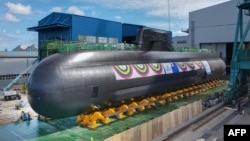The United States is looking to Korean and Japanese shipbuilders to help revive its dormant naval shipyards and boost maritime competitiveness in the face of China's accelerated naval buildup.
U.S. Navy Secretary Carlos Del Toro toured shipyards in South Korea operated by HD Hyundai Heavy Industries in Ulsan and Hanwha Ocean on Geoje Island last week.
He encouraged top executives of the companies to establish subsidiaries and "invest" resources in integrating commercial and naval shipbuilding facilities in the U.S., said a statement by the Navy.
During a speech at Harvard University in September, Del Toro called for "new maritime statecraft" to prevail in an era of intense strategic competition.
South Korean shipbuilding is "an asset" to the U.S. "as China continues to aggressively pursue worldwide shipbuilding dominance," said the Navy statement issued during Del Toro's East Asia visit.
"In addition to our currently active shipyards," it added, "there are numerous former shipyard sites around the country which are largely intact and dormant."
Del Toro said during the tour that these are ready to be redeveloped to produce military and commercial ships.
Yokohama shipyard
Following his visit to South Korea last week, Del Toro traveled to Japan, where he toured Mitsubishi's shipyard in Yokohama and discussed efforts to revive the U.S. maritime industry with leading shipbuilding executives, said the Navy in a separate statement.
Matthew Funaiole, senior fellow for the China Power Project at the Center for Strategic and International Studies, said these meetings "underscore a strategic effort by the U.S. to bolster alliance and enhance technological and industrial cooperation" with its allies.
"China may be the world's largest shipbuilder, but South Korea and Japan are number two and three, respectively," continued Funaiole via email on Tuesday.
China has the largest number of naval vessels in the world, having overtaken the U.S. Navy in 2014. According to a Pentagon report published in October, the People's Liberation Army Navy (PLAN) of China has more than 370 battle force ships compared with the U.S. Navy's 292.
The Pentagon report also said that China's navy is expected to have 395 ships by 2025 and 435 by 2030.
According to the U.S. Naval Institute, China commands almost 50% of the global shipbuilding market, with South Korea and Japan following at nearly 30% and 17%, respectively. US capacity is only 0.13 percent.
"It is clear that the United States is having trouble producing ships – both surface ships and submarines – at numbers and costs that can keep up with China's naval modernization," said Zack Cooper, senior fellow at the American Enterprise Institute and a former Defense Department official during the George W. Bush administration.
"One way to address this shortfall is to work more closely with allies and partners to try and field more vessels or to offload some of the maintenance responsibilities to other players," he told VOA via email on Wednesday.
Protection against competition
But, Cooper said, the opportunities for collaboration "have to be balanced" against the opposition by U.S. shipbuilders that are protected from foreign competitors by the Jones Act.
That act, passed in 1920 in response to German U-boat attacks during World War I that crippled the U.S. Merchant Marine, requires that any vessel carrying goods between two U.S. points be built, owned and crewed by Americans and registered in the U.S.
Terence Roehrig, a professor of national security at the Naval War College, said the U.S. faces a lack of "shipbuilding capacity that can crank out the needed number of vessels at a cost that can be sustained."
He continued via email on Tuesday: "It will be difficult for the U.S. to match the size of the PLAN but the United States retains advantages in technology and weapons systems along with certain classes of ships including aircraft carriers and submarines."
Roehrig added that South Korean and Japanese investment could help the U.S. increase its capacity to keep up with China.
The U.S. Navy currently operates public shipyards in Norfolk, Virginia; Portsmouth, Maine; Puget Sound, Washington; and Pearl Harbor, Hawaii. Seven public shipyards closed from the 1960s to 1990s.
Seven shipyards owned by four contractors in the U.S. build warships for the Navy while China operates more than 20 shipyards to support naval shipbuilding, according to the U.S. Naval Institute.
Funaiole said: "The gap in shipbuilding capabilities can be attributed to several factors, including China's focused efforts on accelerating military modernization through dual-use applications, strategic prioritization of naval expansion to assert its maritime interests, and effective utilization of its commercial industrial capacity."
He continued that the U.S. should warn its international partners about engaging with Chinese commercial shipbuilders.
"These entities often bolster China's military through its Military-Civil Fusion strategy," which aims to eliminate barriers among commercial, scientific and military sectors to enhance its defense.














